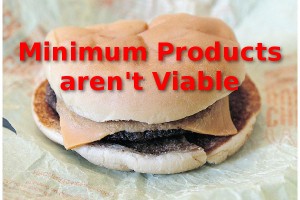Cult of Minimum Viable Product (MVP) kills startups
 Are you sacrificing your success to the cult of Minimum Viable Product? MVP is a popular mantra in the startup world. Like other religious dogma it’s based on half truths & myths, wastes your time & money, and prevents you from finding the truth.
Are you sacrificing your success to the cult of Minimum Viable Product? MVP is a popular mantra in the startup world. Like other religious dogma it’s based on half truths & myths, wastes your time & money, and prevents you from finding the truth.
How does MVP kill startups?
Satisfying customers is the #1 most important goal of a business. If you don’t focus on satisfying customers with laser beam accuracy and Olympic power lifter intensity then give up your dreams of profits. As a startup, your goal is to get enough real paying customers so that your business pays you instead of sucking your life out leaving you to beg in the unemployment line.
Do you actually want a lean startup? Isn’t fat pockets overflowing with cash what you really want? You can have what you really want.
Minimum Viable Product sets the wrong relationship with your potential customers. You want happy customers. You want customers jumping up and down telling their friends how great your product is. You want customers blown away by the tremendous value they get from you.
Minimum Viable Product says give the least customers will accept. Do the least you can get away with then clock out for the day. Apple certainly didn’t get more money than the US government by shovelling junk. If you want premium prices and hoards of fans you better give customers something insanely great. The bare minimum is what third world dictators drop for their poverty ridden suffering slaves. Paying customers have a choice and it isn’t the minimum. Customers want the best and will gladly pay to get it.
Customers Want Value Not Products
Another example of the backwards cult thinking of Minimum Viable Product is the word “product”. Customers don’t care about your product. Customers want the results. If they could get the results without any product that is exactly what they would do.
Customers eagerly pay for valuable results. The more value you can deliver the more money customers will pay and the happier they will be doing it.
I hate silly buzz words and acronyms because it over-simplifies a serious topic that requires some care and thought. If you need a buzz word I suggest this, Most Possible Value (MPV). That puts the focus on the correct things, delivering value.
Deliver the most value you can. What can you profitably deliver with the resources available? That is where most people stumble. They falsely believe they must build super expensive solutions. That leaves most entrepreneurs fearful and willing to cut corners and try to sneak the minimum past. Stop! Delivering value is much easier than building a product.
Remember, customers want value, they want the results. They don’t care how you deliver that value. A super expensive technology product is just one of a very long list of ways to make the results customers value and will pay you to get.
When you break out of the old thinking and focus on delivering value then you can see there are dozens of ways of achieving the real goal of profitably satisfying customers unmet desires.
If this got you thinking then please share it. If you want to join me delivering the Most Possible Value (MVP) then signup so I can tell you how I’m going to help everyone Make Value Happen.
Huge Scary Problem, Simple Cheap Solution
An article in Foreign Policy claims there appears to have been “Military-Style Raid on a California Power Station”.
The second to last paragraph is a perfect example of intelligent innovation.
A shooter “could get 200 yards away with a .22 rifle and take the whole thing out,” Wellinghoff said last month at a conference sponsored by Bloomberg. His proposed defense: A metal sheet that would block the transformer from view. “If you can’t see through the fence, you can’t figure out where to shoot anymore,” Wellinghoff said. Price tag? A “couple hundred bucks.” A lot cheaper than the billions the administration has spent in the past four years beefing up cyber security of critical infrastructure in the United States and on government computer networks.
Systems break at the weakest point. Quite often that means the solution is the simplest thing.
Innovation doesn’t make any random thing better. Innovations improve the most important thing. Innovations must:
- better satisfy the currently most under-satisfied desire
- not reduce the satisfaction of other desires bellow the required level
- not over-satisfy currently satisfied desires



 Predictive Innovation Training
Predictive Innovation Training Predictive Innovation: Core Skills Book
Predictive Innovation: Core Skills Book RoundSquareTriangle.com
RoundSquareTriangle.com